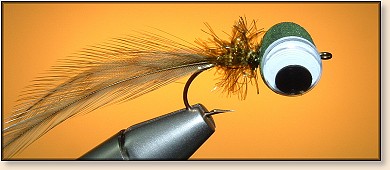Texas BullFrog
By Richard Komar
Let your mind wander back to your childhood for
a moment to the first time you intently watched
a frog in the water as you lay quietly on the
grassy bank or sat motionless on the dock. That
frog probably did not make a chugging sound, a pop
or a gurgling sound. It did not float with its
legs on the surface. The legs were hanging motionless
below the surface. All you could see were the big
eyes on the water's surface. You noticed the frog
propelled itself through the water with a quick kick
of its legs and then the legs hung motionless again.
Resting.
The common flat-faced or cupped face popper doesn't
really represent a frog. The Texas BullFrog imitates
a real frog. It doesn't pop, chug or gurgle, but it
sure catches panfish and bass!
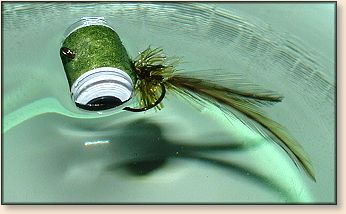
Materials List: Texas BullFrog
Hook: Mustad 3366, Size 2.
Thread: 3/0 or 6/0, Olive.
Hackle: Rooster Cape Feathers, Olive.
Body: Estaz Chenille, Large, Olive.
Head: Soft Foam Cylinder, 1/2" Diameter.
Eyes: Plastic Doll Eyes, 12mm.
Instructions - Texas BullFrog:
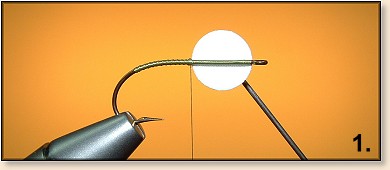
1. Lay a thread base along the hook shank starting
from hook eye, wrapping toward the hook bend. Hold
the foam cylinder up against the hook shank as shown
and wrap backward to the point shown. At this point,
wrap a "thread stop" which will serve as an indicator.
Do not wrap material past this thread stop.
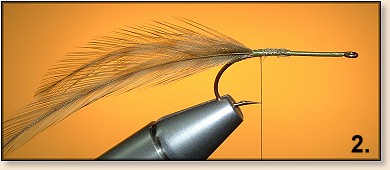
2. Tie in two rooster cape feathers in a splayed,
frog-leg fashion. Make the length of the feathers
twice the length of the hook shank. Yes, TWICE
(bullfrogs have long legs!).
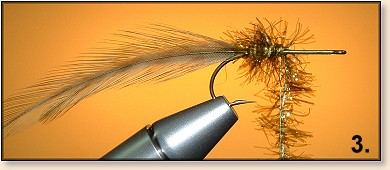
3. Tie in estaz chenille up to the thread stop.
Whip finish and cut the thread. Apply head cement
if desired.
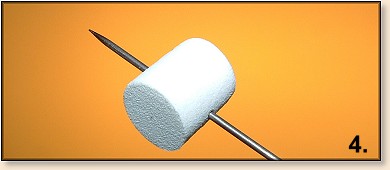
4. Cut a length of soft foam cylinder equal to
the diameter of the cylinder. Using a cigarette
lighter, carefully heat the tip of a bodkin needle
and carefully (lest you impale yourself) insert
the heated needle through the cylinder as shown
(the heated needle goes through the foam easier).
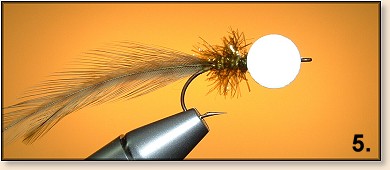
5. Apply super adhesive glue to the exposed part
of the hook shank. Slide the foam cylinder off the
bodkin needle and onto the hook shank (twisting as
you slide makes it easier to position the foam).
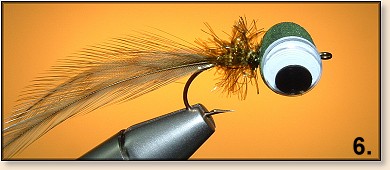
6. Using an olive Prismacolor marker (or equivalent),
color the cylinder. Apply the doll eyes to each end
of the cylinder with super adhesive glue. Viola!
The Texas BullFrog is ready to hop off your vise and
into the water!
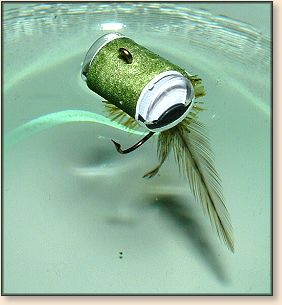
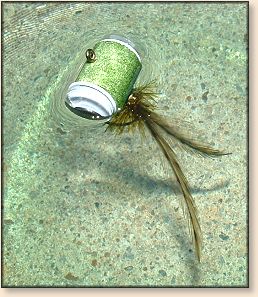
How to Fish the Texas BullFrog:
The Texas BullFrog floats with its "eyes" just above
the surface. Its "legs" hang motionless below the
surface (do not use floatant on the hackle). With
a short tug, its legs come together, the doll eyes
rattle ever so slightly, and the Texas BullFrog
glides forward, then settles down motionless again.
Be ready! This is where the strikes happen! With
a series of tugs, the Texas BullFrog will "swim"
enticingly across an expanse of water, like a real
frog!
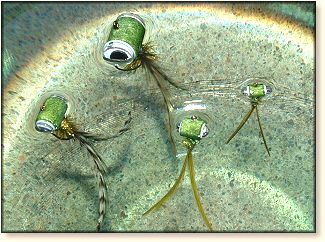
For "BIG" largemouth bass, the Texas BullFrog can be
tied on 2/0 hooks using a ¾' diameter soft foam cylinder
and "BIG" doll eyes. For medium bass, try a size 6
Mustad 94840 hook, ¼" soft foam, 7mm doll eyes, and
medium estaz chenille. For big bluegills, offer them
a size 10 Mustad 94840 hook, 3/8" soft foam, 5mm doll
eyes, and medium estaz chenille. And for smaller panfish,
tempt them with a size 14 Mustad 94840 hook, 3/16" soft
foam, 4mm doll eyes, and medium tinsel chenille. Try
different colors as well! If you fish water with heavy
vegetation, you may want to add a monofilament weed
guard. Have fun! ~ Richard
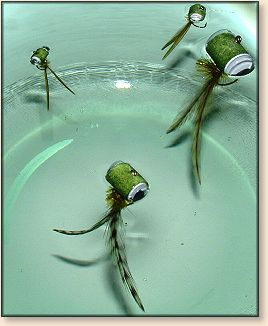
About Richard:
Richard Komar lives in Plano, Texas, is a member
of the Dallas FlyFishers and fishes for panfish
and largemouth bass in the ponds and lakes of
north Texas.
|

